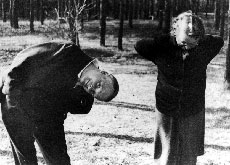Paul Klee, the observer

Through his diaries and abundant correspondence, Paul Klee has left behind statements on his work, his contemporaries and his time.
These, coupled with a study of his works, give us an idea of what the man was like. In an interview with swissinfo, Christine Hopfengart, curator of the Paul Klee Centre, sheds more light on the artist’s life.
swissinfo: Klee’s parents were musicians and he was raised to follow in their footsteps. He started learning the violin at the age of seven and was playing in a Bernese orchestra at 11. Yet he chose to become a painter…
Christine Hopfengart: Klee was pulled in two directions at school. He had started to draw at a very early age, while continuing with violin lessons.
If he had chosen music, he would have followed the path marked out for him by his parents.
By opting for painting, and thus for a different route, he freed himself from the family tradition. It seemed that his father, a man of principles, was never convinced by his son’s career choice, particularly towards the end of his life.
Klee never composed music, remaining an interpreter. With painting, he opted for creation, which corresponded well with his aspiration towards personal freedom.
swissinfo: Isn’t it curious that Klee, a great name of the avantgarde, had conservative musical tastes?
C.H.: It’s true that Bach and Mozart were his idols, and he was always sceptical towards modern music, for example that of his contemporary Arnold Schönberg.
Klee thought that the musical order was complete and that there was nothing more to add to the accomplishments of Bach and Mozart.
He also wrote that he chose the visual arts over music because he saw possibilities of innovation in this field.
swissinfo: Klee’s spontaneous art attracts children and the world of children interested him. He even wrote that he had always remained a child. Why was that?
C.H.: Klee had nothing of the child in him because he was a great intellectual. I would say that the world of children fascinated him because of its creativity, imagination and unconventionality.
Childhood was a sort of ideal, a virginal world, not shaped by education, which corresponded with his work ideal.
In children’s drawings, he rediscovered his own desire to wipe clean the slate of academic traditions and conventions.
swissinfo: Klee preserved a certain sceptical and ironic distance in the face of society and his time. He had an intangible, mysterious, sombre side…
C.H.: Many people found him mysterious because he was very reserved. But he himself was behind this self-mystification by posing as an artist unfathomable in this base world.
However, I would say that Klee was an observer above all. His diaries show that he analysed himself and his environment with an unforgiving precision and without emotional involvement.
When he was young, he could be very strict but, as he got older, his sense of humour shone through.
swissinfo: Persecuted and categorised as a “degenerate artist” by the Nazis, Klee took refuge in Switzerland in 1933. Did he suffer in exile?
C.H.: Certainly, even though he did not talk much about it.
Let’s not forget that when the Nazis rose to power, Klee was at the apogee of an international career. He was famous, his works sold well, the newspapers talked about him, even if they criticised his avantgardism.
And then suddenly, he had to leave all of this behind. By moving to Switzerland, where there was no real artistic scene, he cut himself off from the cultural landscape.
At the beginning, the gravity of the crisis he was going through had an effect on his work. It was almost as if he was paralysed.
swissinfo: In 1935 he was struck down with an incurable illness, which has now been identified as scleroderma. What effect did the disease have on his life?
C.H.: A major effect. In 1936 Klee completed 25 works, hitting the lowest point in his career.
From 1937 onwards, the illness gave him a bout of vitality, a new burst of activity, which resulted in a stupendous creative period.
In 1939 he produced about 1,000 works – it seemed as if the latest crisis in his life had helped him start from scratch.
swissinfo: Klee spent two-thirds of his life in Switzerland but died a German citizen. What relationship did he have with Switzerland?
C.H.: It was mainly an ambivalent relationship. He was born there but left to develop himself further in Munich, at one of the most famous art schools in Europe.
One should always remember that he always came back to Bern to spend his holidays, despite family tensions. He always identified strongly with the Swiss countryside and was a passionate rambler.
But he still felt a bit constrained despite these links and found Bern too quiet and too “bourgeois”.
swissinfo-interview: Isabelle Eichenberger
Paul Klee is born on December 18, 1879, in Münchenbuchsee, near Bern.
1898: He leaves for Munich to study art.
1906: He marries pianist Lily Stumpf.
1907: His son Felix is born.
1916: He is drafted into the German army.
1920: He gains a teaching post as “Meister” at the Bauhaus in Weimar.
1931: He goes to teach at the Fine Arts Academy in Düsseldorf.
1933: Persecuted by the Nazis, he returns to Switzerland.
He dies of scleroderma on June 29, 1940, in Locarno-Muralto.

In compliance with the JTI standards
More: SWI swissinfo.ch certified by the Journalism Trust Initiative
You can find an overview of ongoing debates with our journalists here. Please join us!
If you want to start a conversation about a topic raised in this article or want to report factual errors, email us at english@swissinfo.ch.